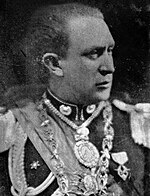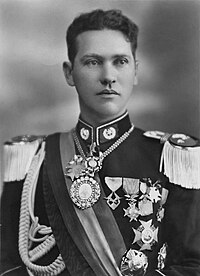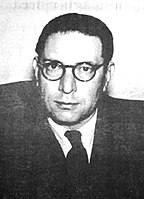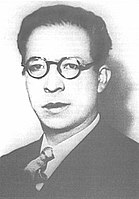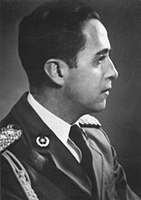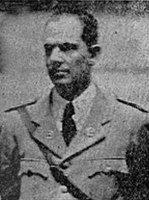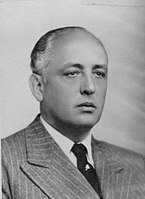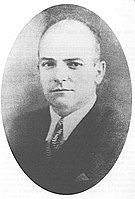
José Luis Tejada Sorzano was a Bolivian lawyer, economist, and politician who served as the 34th president of Bolivia from 1934 to 1936. The last president to be a member of the Liberal Party, Tejada Sorzano previously served as the 23rd vice president of Bolivia from 1931 to 1934.

Víctor Germán Busch Becerra was a Bolivian military officer and statesman who served as the 36th president of Bolivia from 1937 to 1939. Prior to his presidency, he served as the Chief of the General Staff and was the Supreme Leader of the Legion of Veterans, a veterans' organization founded by him after his service in the Chaco War.

Carlos Quintanilla Quiroga was a Bolivian general who served as the 37th president of Bolivia on a provisional basis from 1939 to 1940. Quintanilla saw action in the initial stages of the Chaco War (1932–1935) and managed to ascend the echelon of the Bolivian armed forces until he became commander of the army during the administration of Germán Busch. When President Busch committed suicide on 23 August 1939, Quintanilla declared himself Provisional President of the Republic.
The United Socialist Party was founded on 15 March 1936, as the result of a split in the Nationalist Party in 1936 and the adhesion of some prominent members of the Republican Socialist Party in 1937, and backed by Legion of Veterans and by the regional socialist groups.

The Foreign Minister of Bolivia is the head of the Ministry of Foreign Affairs. The current minister is Rogelio Mayta, who was appointed by president Luis Arce in November 2020.
Bolivia has experienced more than 190 coups d'état and revolutions since its independence in 1825. Since 1950, Bolivia has seen the most coups of any other country. Some people consider the 2019 Bolivian political crisis to be Bolivia's most recent coup. Barring that, the last known attempt was in 1984, four years after the country's transition to democracy in 1980.

Gualberto Villarroel assumed office as the 39th President of Bolivia on 20 December 1943, and his term was violently cut short by his death on 21 July 1946. A colonel during the Chaco War, Villarroel and the Reason for the Fatherland (RADEPA) military lodge joined the fledgling Revolutionary Nationalist Movement (MNR) to overthrow President Enrique Peñaranda in a coup d'état.

Enrique Peñaranda assumed office as the 38th President of Bolivia on 15 April 1940, and his term was terminated by a coup d'état on 20 December 1943. A general in the Chaco War, Peñaranda was brought forth by the traditional conservative political parties, sidelined since the end of the Chaco War, as their candidate in the 1940 general elections.

Germán Busch assumed office as the 36th President of Bolivia on 13 July 1937, and his term was cut short by his death on 23 August 1939. A young military officer during the Chaco War, Busch attempted to champion the cause of Military Socialism brought forth by his predecessor David Toro but, unhappy with the results produced by his few reforms, opted to declare himself dictator in April 1939 before committing suicide four months later.

Carlos Quintanilla assumed office as the interim 37th President of Bolivia on 23 August 1939, and his mandate ended on 15 April 1940. A general of the senior officer corps, Quintanilla assumed control of the presidency on an interim basis following the suicide of his predecessor, Germán Busch.

The 1936 Bolivian coup d'état, also known as the Socialist Revolution of 1936, was a civil-military coup in Bolivia that deposed President José Luis Tejada Sorzano, bringing an end to traditional political order and bringing forward the period of Military Socialism in the country. On 17 May 1936, following the largest strike movement known until then in Bolivia, the military under the young lieutenant colonel Germán Busch overthrew the government of Tejada. Busch held the reins of government until 22 May when Colonel David Toro arrived from the Chaco and assumed the presidency under a military junta supported by the army, organized labor, and the United Socialist Party.

Enrique Hertzog assumed office as the 42nd president of Bolivia on 10 March 1947, and his term ended upon his resignation on 22 October 1949. A physician who served in various ministerial positions since the 1920s, Hertzog was elected as the head of the Republican Socialist Unity Party (PURS) ticket in the 1947 general elections.
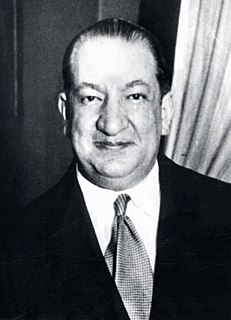
The Cabinet of José Luis Tejada Sorzano was composed of three cabinets which constituted the 94th–96th national cabinets of the Republic of Bolivia. It was led by President José Luis Tejada Sorzano, a Liberal, and was in office from 29 November 1934 to 17 May 1936.
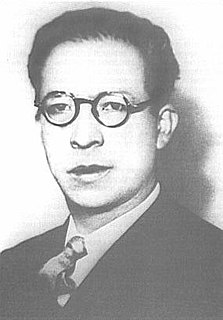
Gabriel Gosálvez Tejada was a Bolivian politician, journalist, economist, and diplomat. Throughout his political career, Gosálvez held various ministerial officers and diplomatic posts as a member of the United Socialist Party. When that party merged into the Republican Socialist Unity Party, Gosálvez was presented as its presidential candidate in the 1951 general election.
The Ministry of Government is a ministry of the Plurinational States of Bolivia. It is tasked with regulating public policy. The current Minister of Government is Eduardo del Castillo since 9 November 2020.
The Government Junta of Bolivia, known from 21 June 1936 as the Military Government Junta, was a civil-military junta which ruled Bolivia from 17 May 1936 through 28 May 1938. It consisted of representatives of both the armed forces as well as the civilian sector, including moderate socialists and organized labor leaders. The President of the Junta was Colonel David Toro who came to power on 22 May 1936, six days after a coup d'état which overthrew the previous government. Toro presided over a reformist experiment known as Military Socialism for a little over a year before being overthrown himself in another coup d'état which allowed Lieutenant Colonel Germán Busch to succeed to lead the junta on 13 July 1937. The junta was dissolved on 28 May 1938 when the National Convention elected Busch Constitutional President of the Republic.
The Government Junta of Bolivia was a civil-military junta which ruled Bolivia from 20 December 1943 through 5 April 1944. It consisted of representatives of the armed forces through the Reason for Fatherland (RADEPA) military lodge as well as members of the Revolutionary Nationalist Movement (MNR). The President of the Junta was Colonel Gualberto Villarroel who came to power after a coup d'état which overthrew the government of Enrique Peñaranda. Immediately upon its inception, the junta faced a diplomatic blockade by the United States who viewed the MNR as sympathetic to the fascist powers of World War II and as such led the rest of Latin America in refusing to recognize the new regime until all members of the MNR were removed from the administration. After months of attempted negotiations and the removal of several cabinet ministers, the government finally relented and dismissed all remaining MNR members, dissolving the junta and entrusting Villarroel with the provisional Presidency of the Republic on 5 April 1944.

Mamerto Urriolagoitía assumed office as the 43rd President of Bolivia on 24 October 1949, and his term was terminated upon his resignation in a self-coup on 16 May 1951. The vice president of Enrique Hertzog, Urriolagoitía had already been serving as acting president since 7 May 1949 but officially took office after Hertzog presented his resignation on 22 October.
The Government Junta of Bolivia, officially known as the Honorable Government Junta, was a civil junta which ruled Bolivia from 21 July 1946 through 10 March 1947. It consisted of labor, teacher, and student representatives as well as magistrates of the Superior District Court of La Paz. The President of the Junta was Superior District Court President Tomás Monje who was appointed following the violent overthrow of President Gualberto Villarroel on 21 July 1946. As Monje was ill at the time of Villarroel's death, Néstor Guillén, the Dean of the Superior District Court, took charge for the first 27 days before delegating command to Monje on 17 August 1946. As President of the Junta, Monje acted as a neutral figure heading the transition back to civilian government. The junta was dissolved on 10 March 1947 when Enrique Hertzog, winner of the January general election, took office as president.
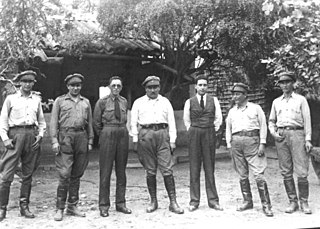
The 1934 Bolivian coup d'état, colloquially known as the Corralito of Villamontes, was a military coup in Bolivia that deposed President Daniel Salamanca in the midst of the Chaco War. Two days before the coup, Salamanca and his presidential delegation arrived at the military headquarters in Villamontes with the intent of removing General Enrique Peñaranda as commander-in-chief of the armed forces and replacing him with General José Leonardo Lanza. In response, on 27 November 1934, army high command directed a group of military officers led by Captain Germán Busch to arrest the president and force his resignation.
